2005 BMW Z4 ROADSTER 2.5I tire size
[x] Cancel search: tire sizePage 32 of 120

Adjustments
30
Safety function
1.Close the driver's door and turn the ignition
key to position 0 or 2
2.Press and hold the desired memory button
1, 2 or 3 until the adjustment process is
completed.
If you press the M
EMORY button accidentally:
Press the button again; the indicator lamp goes
out.
Before activating the programmed
adjustment feature, ensure that the space
behind the driver's seat is empty and unob-
structed. If you fail to do so, objects behind the
seat could be damaged, should the seat move
backward.<
Seat heating*
The seat cushion and backrest can be heated
with the ignition key in position 2.
You can call up different heating modes by
repeatedly pressing the buttons.
The seat heating can also be switched off from
the higher heating modes:
Press the button and hold it slightly longer.
Safety belts
Comply with the instructions on page27,
or the occupants' personal safety will be
diminished.<
Make sure every occupant fastens his or her
safety belt. As supplemental restraint devices,
the airbags are designed to enhance the effec-
tiveness of the safety belts, and not to replace
them.
To fasten
Make sure you hear the lock engage in the belt
buckle.
To unlock
1.Press the red button in the belt buckle
2.Hold the belt
3.Guide the belt back into its reel.
The upper belt attachment point is suitable for
all body sizes, provided that the person is sitting
correctly, refer to page28.
Safety belt reminder
The indicator lamp flashes or lights up.
A signal also sounds. Check if the
safety belts have been properly fas-
tened.
The safety belt reminder is operational above a
speed of approx. 5 mph / 8 km/h. The reminder
can also occur if objects are on the passenger
seat.
Damaged safety belts
If the safety belts are damaged or
stretched in an accident: have the entire
belt system, including the tensioning mecha-
nisms, replaced at your BMW center. Have the
belt anchorage points inspected for damage at
the same time. Failure to observe this precau-
tion may prevent the safety belts from effec-
tively providing optimal protection when
needed.<
Page 80 of 120
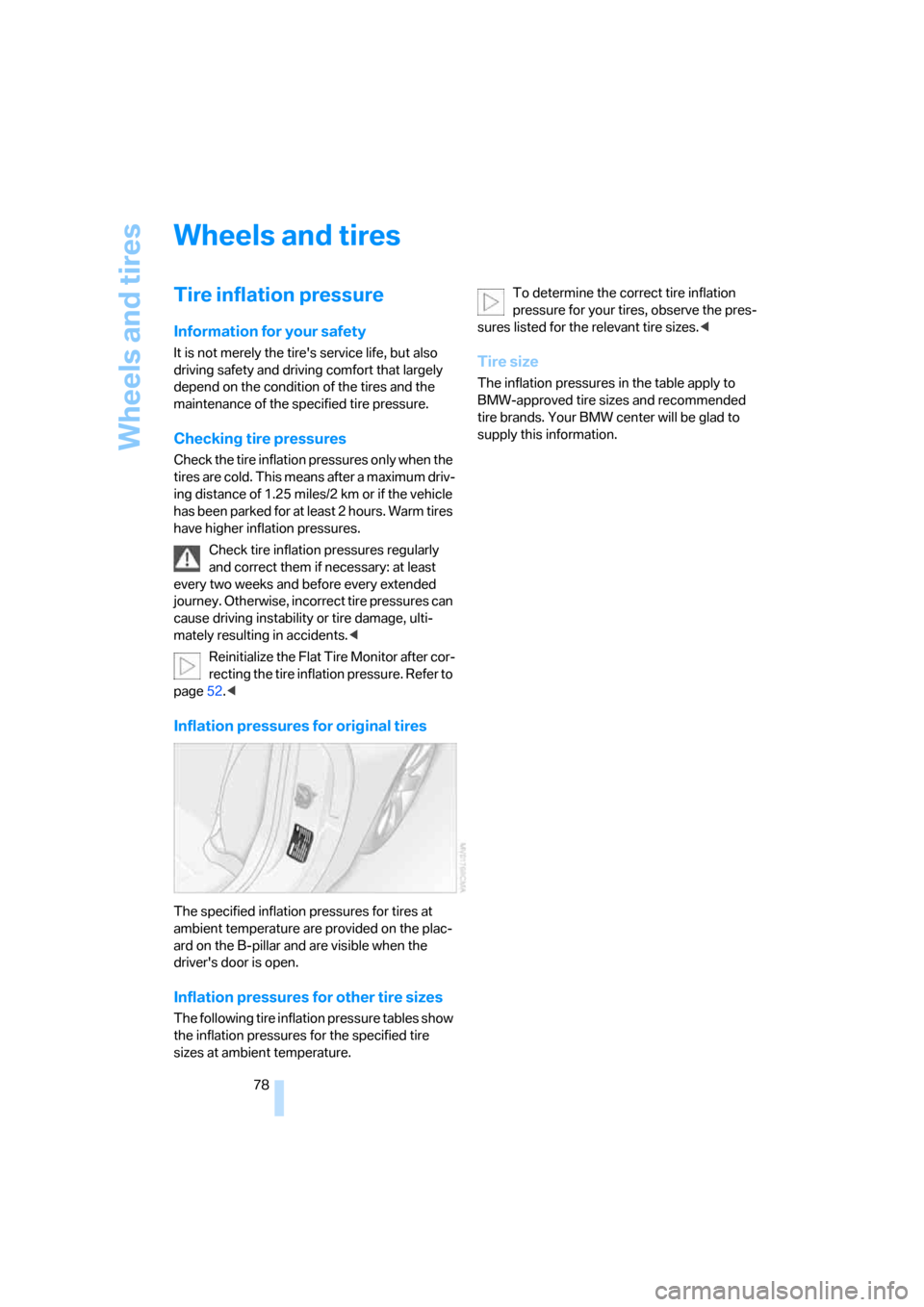
Wheels and tires
78
Wheels and tires
Tire inflation pressure
Information for your safety
It is not merely the tire's service life, but also
driving safety and driving comfort that largely
depend on the condition of the tires and the
maintenance of the specified tire pressure.
Checking tire pressures
Check the tire inflation pressures only when the
tires are cold. This means after a maximum driv-
ing distance of 1.25 miles/2 km or if the vehicle
has been parked for at least 2 hours. Warm tires
have higher inflation pressures.
Check tire inflation pressures regularly
and correct them if necessary: at least
every two weeks and before every extended
journey. Otherwise, incorrect tire pressures can
cause driving instability or tire damage, ulti-
mately resulting in accidents.<
Reinitialize the Flat Tire Monitor after cor-
recting the tire inflation pressure. Refer to
page52.<
Inflation pressures for original tires
The specified inflation pressures for tires at
ambient temperature are provided on the plac-
ard on the B-pillar and are visible when the
driver's door is open.
Inflation pressures for other tire sizes
The following tire inflation pressure tables show
the inflation pressures for the specified tire
sizes at ambient temperature.To determine the correct tire inflation
pressure for your tires, observe the pres-
sures listed for the relevant tire sizes.<
Tire size
The inflation pressures in the table apply to
BMW-approved tire sizes and recommended
tire brands. Your BMW center will be glad to
supply this information.
Page 81 of 120
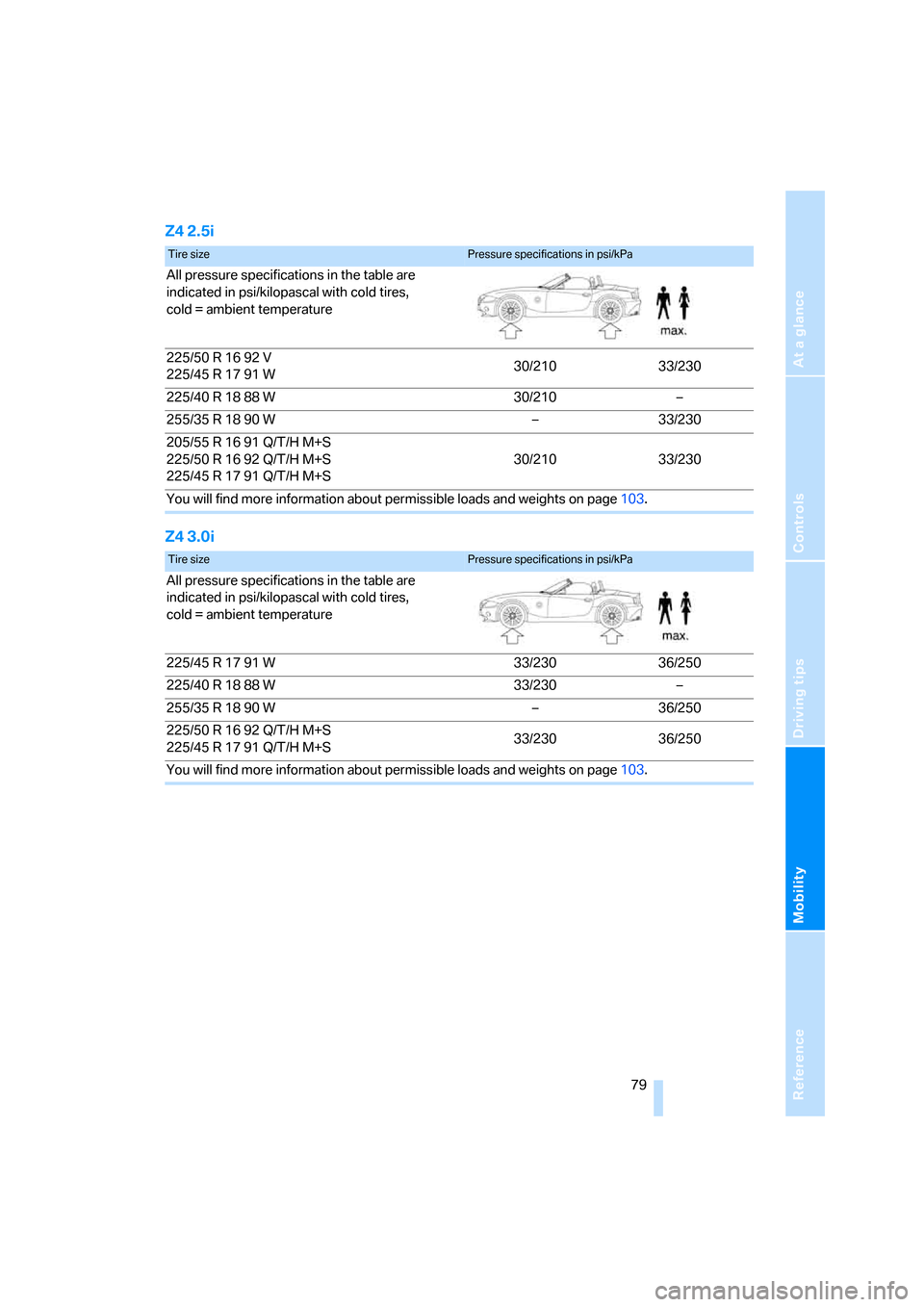
Reference
At a glance
Controls
Driving tips
Mobility
79
Z4 2.5i
Z4 3.0i
Tire sizePressure specifications in psi/kPa
All pressure specifications in the table are
indicated in psi/kilopascal with cold tires,
cold = ambient temperature
225/50 R 16 92 V
225/45 R 17 91 W30/210 33/230
225/40 R 18 88 W 30/210 –
255/35 R 18 90 W – 33/230
205/55 R 16 91 Q/T/H M+S
225/50 R 16 92 Q/T/H M+S
225/45 R 17 91 Q/T/H M+S30/210 33/230
You will find more information about permissible loads and weights on page103.
Tire sizePressure specifications in psi/kPa
All pressure specifications in the table are
indicated in psi/kilopascal with cold tires,
cold = ambient temperature
225/45 R 17 91 W 33/230 36/250
225/40 R 18 88 W 33/230 –
255/35 R 18 90 W – 36/250
225/50 R 16 92 Q/T/H M+S
225/45 R 17 91 Q/T/H M+S33/230 36/250
You will find more information about permissible loads and weights on page103.
Page 82 of 120
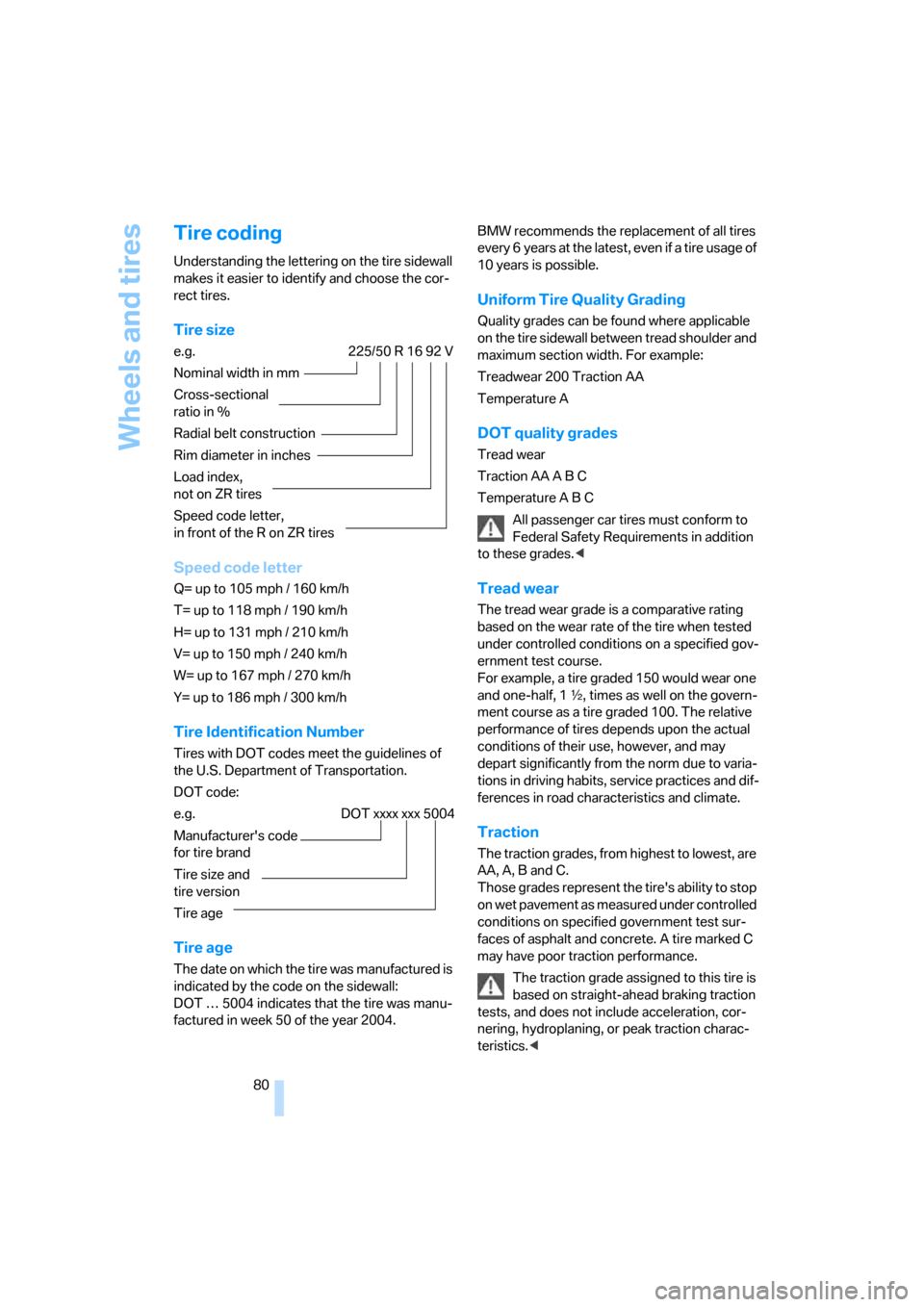
Wheels and tires
80
Tire coding
Understanding the lettering on the tire sidewall
makes it easier to identify and choose the cor-
rect tires.
Tire size
e.g. 225/50 R 16 92 V
Nominal width in mm
Cross-sectional
ratio in %
Radial belt construction
Rim diameter in inches
Load index,
not on ZR tires
Speed code letter,
in front of the R on ZR tires
Speed code letter
Q= up to 105 mph / 160 km/h
T= up to 118 mph / 190 km/h
H= up to 131 mph / 210 km/h
V= up to 150 mph / 240 km/h
W= up to 167 mph / 270 km/h
Y= up to 186 mph / 300 km/h
Tire Identification Number
Tires with DOT codes meet the guidelines of
the U.S. Department of Transportation.
DOT code:
e.g. DOT xxxx xxx 5004
Manufacturer's code
for tire brand
Tire size and
tire version
Tire age
Tire age
The date on which the tire was manufactured is
indicated by the code on the sidewall:
DOT … 5004 indicates that the tire was manu-
factured in week 50 of the year 2004.BMW recommends the replacement of all tires
every 6 years at the latest, even if a tire usage of
10 years is possible.
Uniform Tire Quality Grading
Quality grades can be found where applicable
on the tire sidewall between tread shoulder and
maximum section width. For example:
Treadwear 200 Traction AA
Temperature A
DOT quality grades
Tread wear
Traction AA A B C
Temperature A B C
All passenger car tires must conform to
Federal Safety Requirements in addition
to these grades.<
Tread wear
The tread wear grade is a comparative rating
based on the wear rate of the tire when tested
under controlled conditions on a specified gov-
ernment test course.
For example, a tire graded 150 would wear one
and one-half, 1 γ, times as well on the govern-
ment course as a tire graded 100. The relative
performance of tires depends upon the actual
conditions of their use, however, and may
depart significantly from the norm due to varia-
tions in driving habits, service practices and dif-
ferences in road characteristics and climate.
Traction
The traction grades, from highest to lowest, are
AA, A, B and C.
Those grades represent the tire's ability to stop
on wet pavement as measured under controlled
conditions on specified government test sur-
faces of asphalt and concrete. A tire marked C
may have poor traction performance.
The traction grade assigned to this tire is
based on straight-ahead braking traction
tests, and does not include acceleration, cor-
nering, hydroplaning, or peak traction charac-
teristics.<
Page 84 of 120
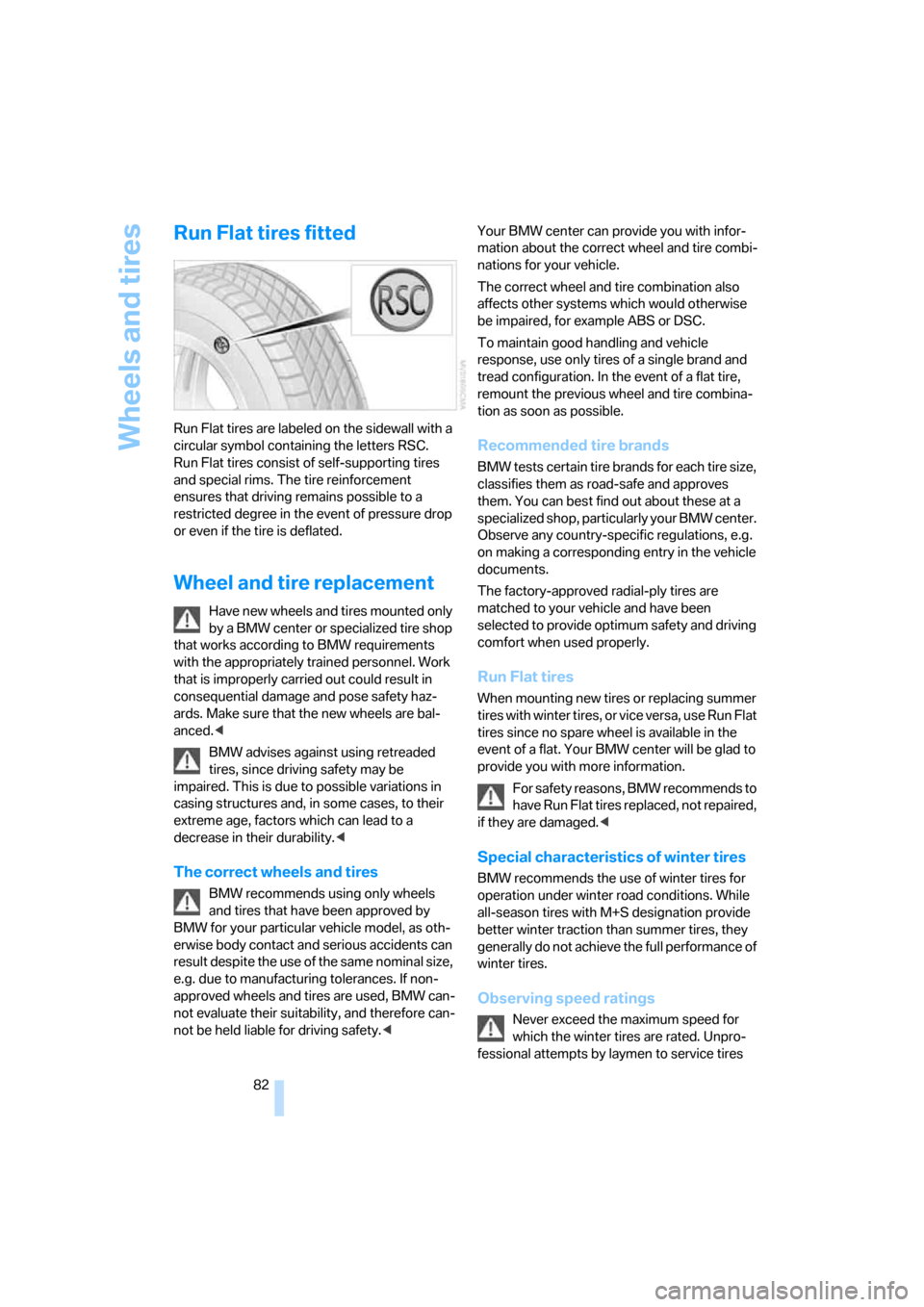
Wheels and tires
82
Run Flat tires fitted
Run Flat tires are labeled on the sidewall with a
circular symbol containing the letters RSC.
Run Flat tires consist of self-supporting tires
and special rims. The tire reinforcement
ensures that driving remains possible to a
restricted degree in the event of pressure drop
or even if the tire is deflated.
Wheel and tire replacement
Have new wheels and tires mounted only
by a BMW center or specialized tire shop
that works according to BMW requirements
with the appropriately trained personnel. Work
that is improperly carried out could result in
consequential damage and pose safety haz-
ards. Make sure that the new wheels are bal-
anced.<
BMW advises against using retreaded
tires, since driving safety may be
impaired. This is due to possible variations in
casing structures and, in some cases, to their
extreme age, factors which can lead to a
decrease in their durability.<
The correct wheels and tires
BMW recommends using only wheels
and tires that have been approved by
BMW for your particular vehicle model, as oth-
erwise body contact and serious accidents can
result despite the use of the same nominal size,
e.g. due to manufacturing tolerances. If non-
approved wheels and tires are used, BMW can-
not evaluate their suitability, and therefore can-
not be held liable for driving safety.
nations for your vehicle.
The correct wheel and tire combination also
affects other systems which would otherwise
be impaired, for example ABS or DSC.
To maintain good handling and vehicle
response, use only tires of a single brand and
tread configuration. In the event of a flat tire,
remount the previous wheel and tire combina-
tion as soon as possible.
Recommended tire brands
BMW tests certain tire brands for each tire size,
classifies them as road-safe and approves
them. You can best find out about these at a
specialized shop, particularly your BMW center.
Observe any country-specific regulations, e.g.
on making a corresponding entry in the vehicle
documents.
The factory-approved radial-ply tires are
matched to your vehicle and have been
selected to provide optimum safety and driving
comfort when used properly.
Run Flat tires
When mounting new tires or replacing summer
tires with winter tires, or vice versa, use Run Flat
tires since no spare wheel is available in the
event of a flat. Your BMW center will be glad to
provide you with more information.
For safety reasons, BMW recommends to
have Run Flat tires replaced, not repaired,
if they are damaged.<
Special characteristics of winter tires
BMW recommends the use of winter tires for
operation under winter road conditions. While
all-season tires with M+S designation provide
better winter traction than summer tires, they
generally do not achieve the full performance of
winter tires.
Observing speed ratings
Never exceed the maximum speed for
which the winter tires are rated. Unpro-
fessional attempts by laymen to service tires
Page 117 of 120
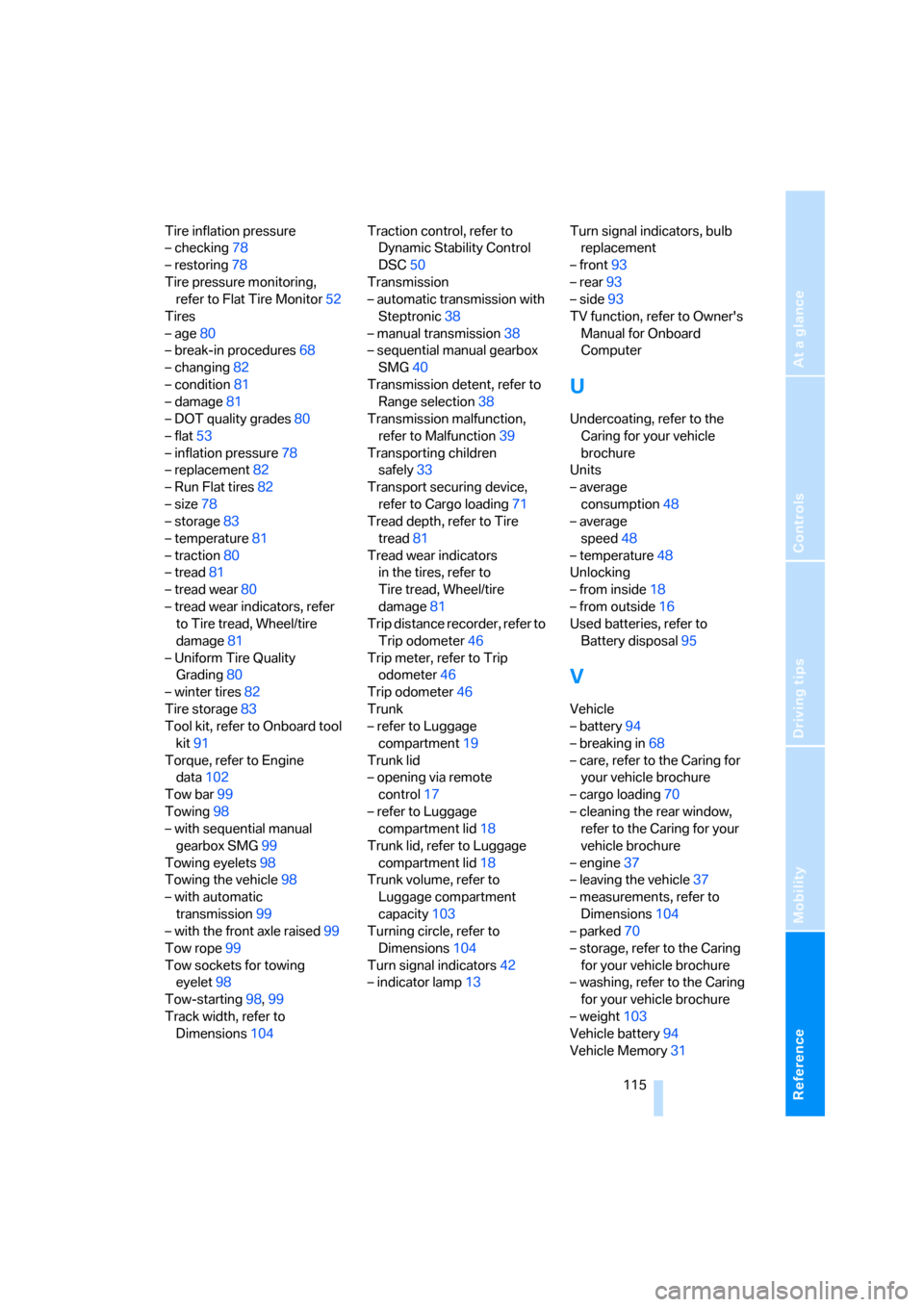
Reference
At a glance
Controls
Driving tips
Mobility
115
Tire inflation pressure
– checking78
– restoring78
Tire pressure monitoring,
refer to Flat Tire Monitor52
Tires
– age80
– break-in procedures68
– changing82
– condition81
– damage81
– DOT quality grades80
– flat53
– inflation pressure78
– replacement82
– Run Flat tires82
– size78
– storage83
– temperature81
– traction80
– tread81
– tread wear80
– tread wear indicators, refer
to Tire tread, Wheel/tire
damage81
– Uniform Tire Quality
Grading80
– winter tires82
Tire storage83
Tool kit, refer to Onboard tool
kit91
Torque, refer to Engine
data102
Tow bar99
Towing98
– with sequential manual
gearbox SMG99
Towing eyelets98
Towing the vehicle98
– with automatic
transmission99
– with the front axle raised99
Tow rope99
Tow sockets for towing
eyelet98
Tow-starting98,99
Track width, refer to
Dimensions104Traction control, refer to
Dynamic Stability Control
DSC50
Transmission
– automatic transmission with
Steptronic38
– manual transmission38
– sequential manual gearbox
SMG40
Transmission detent, refer to
Range selection38
Transmission malfunction,
refer to Malfunction39
Transporting children
safely33
Transport securing device,
refer to Cargo loading71
Tread depth, refer to Tire
tread81
Tread wear indicators
in the tires, refer to
Tire tread, Wheel/tire
damage81
Trip distance recorder, refer to
Trip odometer46
Trip meter, refer to Trip
odometer46
Trip odometer46
Trunk
– refer to Luggage
compartment19
Trunk lid
– opening via remote
control17
– refer to Luggage
compartment lid18
Trunk lid, refer to Luggage
compartment lid18
Trunk volume, refer to
Luggage compartment
capacity103
Turning circle, refer to
Dimensions104
Turn signal indicators42
– indicator lamp13Turn signal indicators, bulb
replacement
– front93
– rear93
– side93
TV function, refer to Owner's
Manual for Onboard
Computer
U
Undercoating, refer to the
Caring for your vehicle
brochure
Units
– average
consumption48
– average
speed48
– temperature48
Unlocking
– from inside18
– from outside16
Used batteries, refer to
Battery disposal95
V
Vehicle
– battery94
– breaking in68
– care, refer to the Caring for
your vehicle brochure
– cargo loading70
– cleaning the rear window,
refer to the Caring for your
vehicle brochure
– engine37
– leaving the vehicle37
– measurements, refer to
Dimensions104
– parked70
– storage, refer to the Caring
for your vehicle brochure
– washing, refer to the Caring
for your vehicle brochure
– weight103
Vehicle battery94
Vehicle Memory31